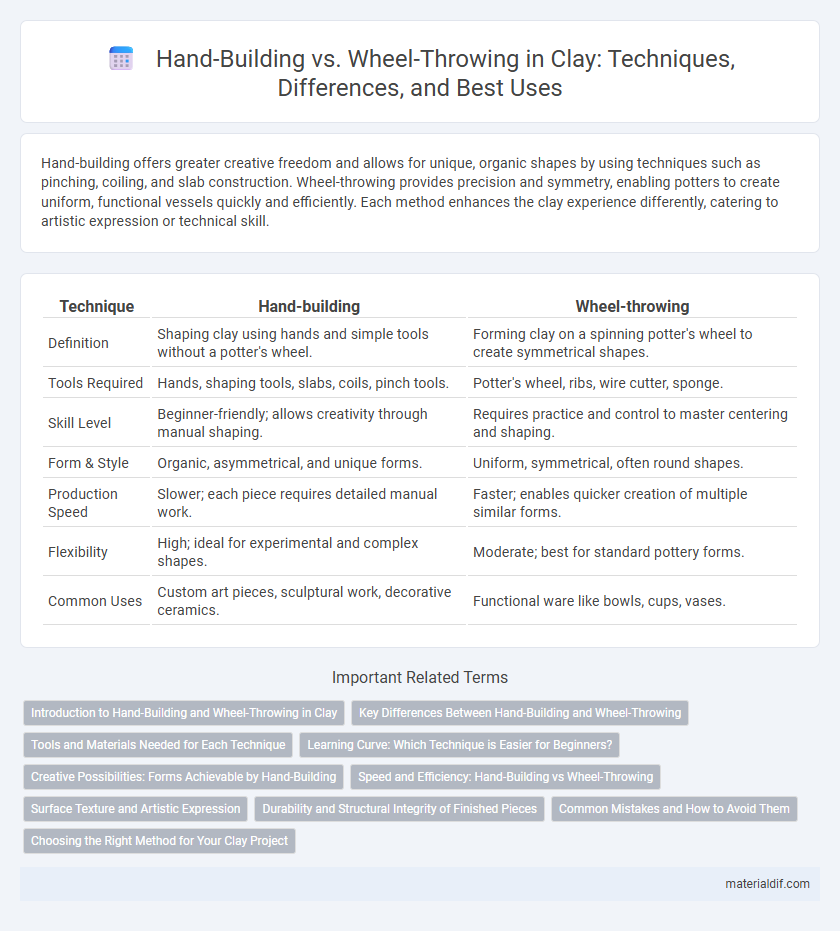Hand-building offers greater creative freedom and allows for unique, organic shapes by using techniques such as pinching, coiling, and slab construction. Wheel-throwing provides precision and symmetry, enabling potters to create uniform, functional vessels quickly and efficiently. Each method enhances the clay experience differently, catering to artistic expression or technical skill.
Table of Comparison
| Technique | Hand-building | Wheel-throwing |
|---|---|---|
| Definition | Shaping clay using hands and simple tools without a potter's wheel. | Forming clay on a spinning potter's wheel to create symmetrical shapes. |
| Tools Required | Hands, shaping tools, slabs, coils, pinch tools. | Potter's wheel, ribs, wire cutter, sponge. |
| Skill Level | Beginner-friendly; allows creativity through manual shaping. | Requires practice and control to master centering and shaping. |
| Form & Style | Organic, asymmetrical, and unique forms. | Uniform, symmetrical, often round shapes. |
| Production Speed | Slower; each piece requires detailed manual work. | Faster; enables quicker creation of multiple similar forms. |
| Flexibility | High; ideal for experimental and complex shapes. | Moderate; best for standard pottery forms. |
| Common Uses | Custom art pieces, sculptural work, decorative ceramics. | Functional ware like bowls, cups, vases. |
Introduction to Hand-Building and Wheel-Throwing in Clay
Hand-building in clay involves shaping forms using techniques like pinching, coiling, and slab construction without a potter's wheel, allowing for more organic and sculptural creations. Wheel-throwing uses a spinning wheel to center and shape clay symmetrically, ideal for creating uniform pottery such as bowls, vases, and cups. Both methods emphasize tactile engagement with clay but differ significantly in technique, tool use, and final aesthetic possibilities.
Key Differences Between Hand-Building and Wheel-Throwing
Hand-building clay involves shaping forms manually using techniques such as pinching, coiling, and slab construction, allowing for greater control over texture and asymmetry. Wheel-throwing relies on a spinning potter's wheel to create symmetrical, cylindrical shapes quickly, requiring skillful manipulation of the clay's centripetal force. The key differences lie in the tactile, slow shaping process of hand-building versus the dynamic, speed-oriented method of wheel-throwing, impacting the final form and surface quality.
Tools and Materials Needed for Each Technique
Hand-building clay requires basic tools such as wooden modeling sticks, wire cutters, rolling pins, and sponges, along with materials like slab or coil clay types that are pliable and easy to shape. Wheel-throwing demands a pottery wheel, a bat, ribs, trimming tools, and specific clay bodies with higher plasticity and moisture retention to withstand centrifugal forces. Both techniques utilize water and clay but differ significantly in tool specialization and clay consistency to achieve optimal results.
Learning Curve: Which Technique is Easier for Beginners?
Hand-building offers a gentler learning curve for beginners, allowing more control over shapes without requiring perfect timing or speed. Wheel-throwing demands mastering wheel speed, centering the clay, and coordinated hand movements, which can be challenging initially. Many beginners find hand-building more accessible before progressing to the technical skills of wheel-throwing.
Creative Possibilities: Forms Achievable by Hand-Building
Hand-building techniques such as coiling, pinching, and slab construction allow for highly creative and unique clay forms that are often difficult to replicate on a wheel. Organic shapes, asymmetrical designs, and intricate textures are more easily achieved through hand-building, offering limitless possibilities for artistic expression. This method supports sculptural elements and complex surface treatments that push the boundaries of traditional pottery.
Speed and Efficiency: Hand-Building vs Wheel-Throwing
Hand-building clay allows for greater control and creativity in shaping unique forms but is generally slower and less efficient for producing multiple pieces quickly. Wheel-throwing accelerates the creation process by enabling rapid, symmetrical shaping of vessels, making it ideal for mass production or when uniformity is desired. Speed and efficiency in wheel-throwing stem from the wheel's rotational motion, reducing manual shaping time compared to the slower, more deliberate hand-building techniques.
Surface Texture and Artistic Expression
Hand-building allows for a highly tactile surface texture with organic, uneven patterns that emphasize individual artistic expression. Wheel-throwing produces smooth, symmetrical forms with consistent textures, ideal for refined and repetitive designs. Artists often combine both techniques to explore diverse surface finishes and unique creative possibilities in clay art.
Durability and Structural Integrity of Finished Pieces
Hand-built clay pieces often exhibit greater durability due to thicker walls and reinforced joins, which enhance structural integrity. Wheel-thrown ceramics typically feature more uniform thickness but may be prone to thinner areas that can compromise strength if not carefully managed. Proper firing techniques and clay body selection play crucial roles in maximizing the durability of both hand-built and wheel-thrown pottery.
Common Mistakes and How to Avoid Them
Hand-building clay often leads to uneven wall thickness, causing cracking during drying or firing; using consistent coil sizes and smoothing joints can prevent these issues. Wheel-throwing mistakes include improper centering and overworking the clay, which can result in collapse or warping; maintaining steady pressure and practicing controlled movements improve form stability. Both techniques benefit from proper moisture control and patience, ensuring stronger, more durable ceramics.
Choosing the Right Method for Your Clay Project
Hand-building offers unmatched versatility for creating unique, sculptural clay pieces, ideal for intricate designs and small-scale projects. Wheel-throwing excels in producing symmetrical forms like bowls and vases rapidly, perfect for functional pottery with consistent shapes. Selecting the right method depends on project goals, clay type, and desired finish, balancing artistic expression with technical skill.
Hand-building vs Wheel-throwing Infographic

 materialdif.com
materialdif.com